Menus
- What you must remember
- Themore
- Theless
- Prices
- Make yourHonda RC 30 – VFR 750 R 1988
- Opinion
- Performances
- The technical aspect
- Competitors
- Gallery
- Related articles
We are in 1987. Cyril Neveu has just won the Paris-Dakar for the fifth time; The Airbus A320 has just taken off; Ferrari unveils the F 40; A small TV channel is born: M6; We are starting to build the Channel Tunnel; But the important thing is not there…. The world will soon be turned upside down again. While the recent Suzuki 750 and 1100 GSX-R have just significantly increased the speed of the Earth’s rotation, a new machine will hatch from the paddocks. A girl from the track, whose initials will soon become the abbreviation of a fantasy. 4 signs, which will be symbolic and absolute: RC 30.
It sounds like the code name for a US Air Force fighter. A sports car like no other, a 750 that plays in a different court than the GSX-R, FZ and ZXR. No, not a sports car – a racing machine, designed for the track and approved for the road. An uncompromising creation of the HRC, beautiful, sublime, endowed with an eloquent genetic heritage. It comes directly from the RVF endurance factory, itself drawing its inspiration from the speed 500. Exceptional? No ambiguity on this. There’s no doubt about it when you consider that this bike is hand-assembled directly at the HRC. Its goal is not hidden: the Superbike. A promising championship that the FIM will launch next year (Today, more than 20 years later, the SBK has become one of the most resounding world motorcycle championships).
First there is this silhouette. Picked up, low, tight, uncompromising, like a GP 500. A 7 and a half cut for performance, where every detail proves the RC 30’s involvement in the competition. Let’s remove this fairing and discover what is hidden under this FRB (Fiber Reinforced Plastic) assembly, a material that is lighter but also more resistant than plastic. It only took a few moments, as the (handcrafted) cover is held in place by large clips attached behind the elements. Once naked, admiration and confusion overwhelm us. The race is here, on edge.
 Come closer. Closer still. From afar, the superb chassis disappears under the mess of hoses, cables and other peripherals. You have to be close enough, until you can smell the aluminum scent, to detail and revel in the heart of the RC 30, its V4. An engine not widely used in 4-stroke sports cars, the leitmotif of which I will quickly remind you: the power and speeds of a 4-cylinder without its imposing width. Enough to refine a motorcycle, improve its aerodynamics, without sacrificing power. And this boiler alone justifies the exceptional nature of this machine. A few figures: 748 cm3, an opening angle between the cylinder banks of 90 °, a setting of 360 ° for an explosion per revolution of the vilo, a red zone at 12,500 rpm, and 91 horsepower at the output. WHAT !!! This is a joke ?!?
Come closer. Closer still. From afar, the superb chassis disappears under the mess of hoses, cables and other peripherals. You have to be close enough, until you can smell the aluminum scent, to detail and revel in the heart of the RC 30, its V4. An engine not widely used in 4-stroke sports cars, the leitmotif of which I will quickly remind you: the power and speeds of a 4-cylinder without its imposing width. Enough to refine a motorcycle, improve its aerodynamics, without sacrificing power. And this boiler alone justifies the exceptional nature of this machine. A few figures: 748 cm3, an opening angle between the cylinder banks of 90 °, a setting of 360 ° for an explosion per revolution of the vilo, a red zone at 12,500 rpm, and 91 horsepower at the output. WHAT !!! This is a joke ?!?
Indeed, there is something to ruffle the hair. But this is the restraint for France. And let’s not complain too much: the Japanese version calmed down to 77 hp. Let’s breathe a bit knowing that the normal version develops 112 nags, and that the transplant of an HRC kit allows it to climb up to 122 hp. And if the heart (as well as the wallet) tells you, the TTF1 kit announces a power of 133 hp. Fortunately, the titanium connecting rods are intended to hold up..
Before installing these kits, let’s take a look at the concern for compactness and efficiency demonstrated by HRC engine manufacturers. Starting with the valves fitted with pushrods guided in the cylinder head allowing direct attack by the cams of the ACTs; resulting in less friction, lighter cylinder head, and 6 ° raised intake pipes as well as straighter ducts. The drive of the distribution by cascade of pinions offers a precision rarely seen, without counting this very particular whistle and the worry in less of the replacement of two chains. The carbs are 35 mm specially designed for this VFR-R. And for cooling, 2 remarkable curved radiators evacuate the calories.
 A little hint from the HRC that deserves our full attention is the anti-dribble mechanism installed in the clutch. In the event of an incorrectly calculated downshift at high speed, the residual torque undigested by the engine will cause the rear wheel to dribble or lock up. Honda has installed a torque limiter which acts on the clutch discs. In case of overload, the system acts on 3 discs, reducing the torque by about 35%.
A little hint from the HRC that deserves our full attention is the anti-dribble mechanism installed in the clutch. In the event of an incorrectly calculated downshift at high speed, the residual torque undigested by the engine will cause the rear wheel to dribble or lock up. Honda has installed a torque limiter which acts on the clutch discs. In case of overload, the system acts on 3 discs, reducing the torque by about 35%.
Road machine requires, the RC 30 weighs 18 kg more on the scale than the official RVF – But the V4, it weighs exactly the same weight in one or the other machine: 75 kg.
Around this small technological temple, Honda has taken care to put a chassis up to the task. The frame, for example, is not really a double perimeter aluminum beam like the others – it comes from the same molds as the RVF; but slightly reinforced to withstand the stresses of the road. Anchored to its reeds, we touch the sublime: a magnificent pro-arm single-arm, the fruit of the love between Honda and ELF. Such a part on a road sports car is a dream. On one side is added a superb multi-spoke rim, on the other we can see that all the nuts of the crown are braked with wire, as in  compet ’. Moreover, the variations between the RVF and the RC 30 are numerous: identical design for the very wide cast aluminum wheels (magnesium on the RVF), 43 mm quick-release fork with double adjustment (rebound and compression), tee upper in polished aluminum, single-shock absorber with separate cylinder adjustable in compression and rebound, dual 310 mm front discs clamped by 4-piston calipers (designed to facilitate a quick change of pads), and a multitude of details that are both efficient and lightweight and can be changed in no time.
compet ’. Moreover, the variations between the RVF and the RC 30 are numerous: identical design for the very wide cast aluminum wheels (magnesium on the RVF), 43 mm quick-release fork with double adjustment (rebound and compression), tee upper in polished aluminum, single-shock absorber with separate cylinder adjustable in compression and rebound, dual 310 mm front discs clamped by 4-piston calipers (designed to facilitate a quick change of pads), and a multitude of details that are both efficient and lightweight and can be changed in no time.
Crazy stuff? No, just the best for the best sports. A machine that few would have dreamed of being on the road one day. But there it is ! Honda did, and certainly offers the most iconic motorcycle of the 80s..
Considered one of Honda’s most prestigious models, more than 4,700 units of the RC 30 have been produced, each started with a carbon-encrusted key. The victories that can be recorded in his record make you dizzy: several times the Bol d’Or, the 24 hours of Le Mans and the 8 hrs of Suzuka, victories and titles in all the world Superbike championships, a crowd of success at the Tourist Trophy. But this dream comes at a price: almost 90,000 francs. Ah yes, that’s the slap no one wants to know. But is it really so unreasonable to have Sarron’s motorcycle in the garage ?
* 90,000 francs, what did that represent at the time? About 19 months of minimum wage, almost a Renault 5 GT Turbo, 2 GSX-R 750, more than 30,000 baguettes of bread, or even 18,600 liters of SP 95.
This little promotional video from the time clearly shows the passion and goldsmith work that Honda showed for its RC 30.
What you must remember
Themore
Theless
Prices
13,319 €
Price
nine
Compare
the credits
Make
yourHonda RC 30 – VFR 750 R 1988
Estimate, calculate and compare the cost of insuring your motorcycle.
Calculate the cost of
insurance
Test the price of the motorcycle insurance specialist
Opinion
on 1 opinion
users
Read the reviews
Model marketed in
1988
1989
1990
1991
Performances
-
Max speed:
approx. 255 km / h -
Consumption
medium: 9 l
The technical aspect
Honda RC 30 – VFR 750 R 1988
- Frame
- Frame: diamond type, double aluminum beam
- Tank: 18 liters
- Seat height: 785 mm
- Length: 2,045 mm
- Width: 700 mm
- Height: 1,100 mm
- Wheelbase: 1,410 mm
- Dry weight: 185 kg
- Weight in running order: 208 kg
- Train before
- Telehydraulic fork Ø 43 mm, deb: 120 mm
- 2 discs Ø 310mm, calipers with 4 opposed pistons
- Front wheel:
120/70
– 17
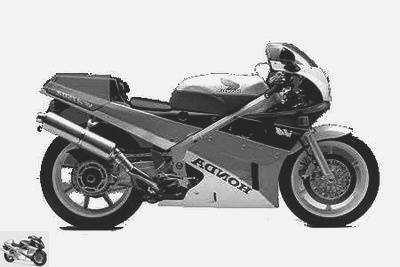
- Transmission
- 6-speed
- final by chain
- Rear axle
- Pro-Arm single-sided arm with shock absorber, deb: 130 mm
- 1 disc Ø 220mm, 2 piston caliper
- Rear wheel:
170/60
– 18
- Motor
- 4 Cylinders
in V at 90 °
, 4 stroke - Cooling: Liquid cooling
- 4 carbs Ø 38 mm
- by cascade pinions, 2 AC
- 4 valves per cylinder
-
748.14 cc
(70 x 48.6 mm) -
112
ch
at 11,500 rpm -
7.38 mkg
at 11,000 rpm - Weight ratio /
power
: 1.65
kg / hp - Compression: 11: 1
- Crit’air:
Detached pieces
exhaust
motor
fluid
electricity
filtration
braking
chain kit
Competitors
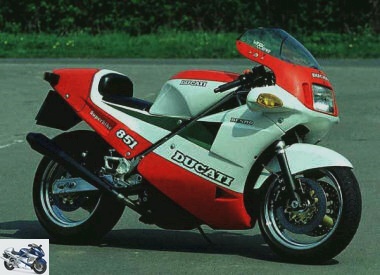
Ducati 851 1988
Gallery
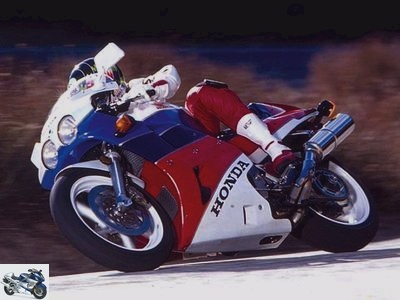
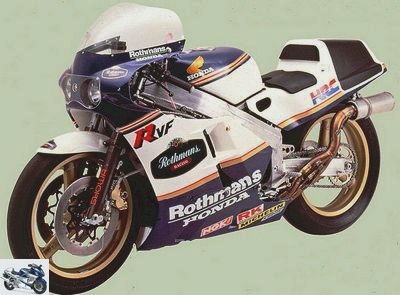

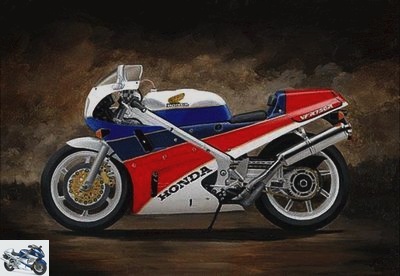
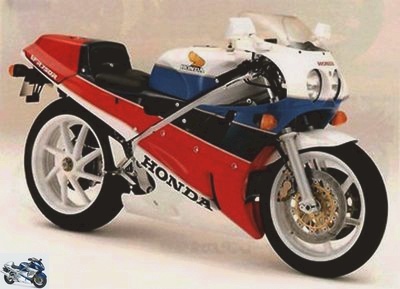
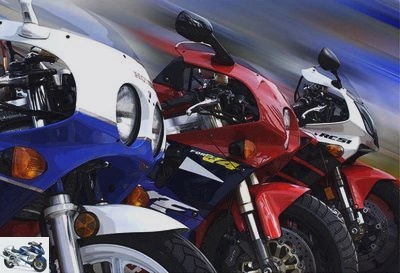

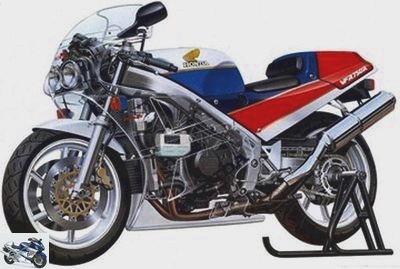
Related articles
-
If the evolution of the CBR 600 in 91 marked a clear break in style with the previous generation, the 95 livery is visually wiser in its evolution. It…
-
We are in 1987. Cyril Neveu has just won the Paris-Dakar for the fifth time; The Airbus A320 has just taken off; Ferrari unveils the F 40; A small TV…
-
We are in 1987. Cyril Neveu has just won the Paris-Dakar for the fifth time; The Airbus A320 has just taken off; Ferrari unveils the F 40; A small TV…
-
* To protest against the arms race of the manufacturers, the press of the time did not publish the test of the 130 hp version. * Carried away by the…
-
We are in 1987. Cyril Neveu has just won the Paris-Dakar for the fifth time; The Airbus A320 has just taken off; Ferrari unveils the F 40; A small TV…
-
Beneath its sporty demeanor, the VFR is not content with being a very good machine; it is also a complete commercial success. Nothing surprising in view…
-
Beneath its sporty demeanor, the VFR is not content to be a very good machine; it is also a complete commercial success. Nothing surprising in view of…
-
Beneath its sporty demeanor, the VFR is not content to be a very good machine; it is also a complete commercial success. Nothing surprising in view of…
-
If the evolution of the CBR 600 in 91 marked a clear break in style with the previous generation, the 95 livery is visually wiser in its evolution. It…
-
Honda CBR 900 RR FIREBLADE 2000
Jostled by the R1 and threatened by the recent ZX-9R, the 900 CBR, is seen from top to bottom to return to the top of the hypersports hierarchy. And at…